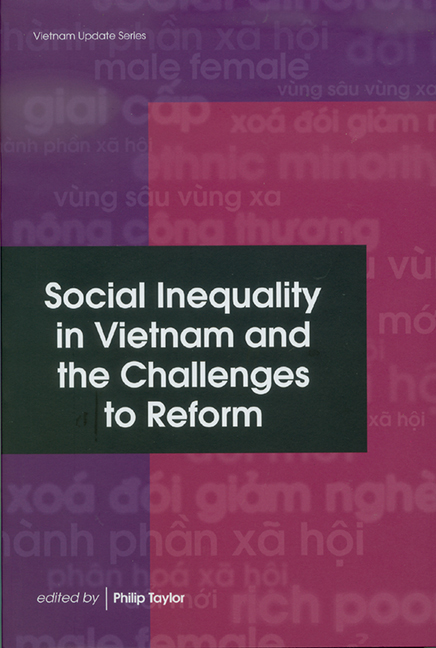Book contents
- Frontmatter
- Contents
- List of Tables
- List of Figures
- Preface
- Introduction: Social Inequality in a Socialist State
- 1 Vietnam's Recent Political Developments
- 2 Vietnam's Recent Economic Reforms and Developments: Achievements, Paradoxes, and Challenges
- 3 Behind the Numbers: Social Mobility, Regional Disparities, and New Trajectories of Development in Rural Vietnam
- 4 From Collectivization to Globalization: Social Differentiation in a Muong Ethnic Community of Vietnam
- 5 Political Capital, Human Capital, and Inter-generational Occupational Mobility in Northern Vietnam
- 6 Social Disparities in Vietnam: The Case of Poverty Reduction and Educational Attainment
- 7 Redressing Disadvantage or Re-arranging Inequality? Development Interventions and Local Responses in the Mekong Delta
- 8 The Politics of Land: Inequality in Land Access and Local Conflicts in the Red River Delta since Decollectivization
- 9 Female Garment Workers: The New Young Volunteers in Vietnam's Modernization
- 10 Class, Nation, and Text: The Representation of Peasants in Vietnamese Literature
- 11 Leisure and Social Mobility in Ho Chi Minh City
- Index
- About the Contributors
- Publications in the Vietnam Update Series
9 - Female Garment Workers: The New Young Volunteers in Vietnam's Modernization
Published online by Cambridge University Press: 21 October 2015
- Frontmatter
- Contents
- List of Tables
- List of Figures
- Preface
- Introduction: Social Inequality in a Socialist State
- 1 Vietnam's Recent Political Developments
- 2 Vietnam's Recent Economic Reforms and Developments: Achievements, Paradoxes, and Challenges
- 3 Behind the Numbers: Social Mobility, Regional Disparities, and New Trajectories of Development in Rural Vietnam
- 4 From Collectivization to Globalization: Social Differentiation in a Muong Ethnic Community of Vietnam
- 5 Political Capital, Human Capital, and Inter-generational Occupational Mobility in Northern Vietnam
- 6 Social Disparities in Vietnam: The Case of Poverty Reduction and Educational Attainment
- 7 Redressing Disadvantage or Re-arranging Inequality? Development Interventions and Local Responses in the Mekong Delta
- 8 The Politics of Land: Inequality in Land Access and Local Conflicts in the Red River Delta since Decollectivization
- 9 Female Garment Workers: The New Young Volunteers in Vietnam's Modernization
- 10 Class, Nation, and Text: The Representation of Peasants in Vietnamese Literature
- 11 Leisure and Social Mobility in Ho Chi Minh City
- Index
- About the Contributors
- Publications in the Vietnam Update Series
Summary
My mother often told me that it is not easy for garment girls to get married. I think it is quite true. In my previous workshop, there were 42 workers and we all were girls. No boys. We were working and living in the same place. After finishing work at 7 or 8 o'clock in the evening, the guard locked the main door so that we could not go out and no one could come in. He was afraid because we were all girls and far away from our families. Because our parents asked him to take care of us, he was afraid of not knowing what to say to our parents, in the event that “something bad” happened to us. (A garment worker in a private workshop in Co Nhue)
In Vietnam unmarried women, still living in their parents' home, are often compared to bombs that can explode at any moment. It is quite significant that the sexuality of unmarried women is compared to something as violent and destructive as a bomb. As the above quote demonstrates, such a view is also prevalent in the fastest-growing industry in Vietnam since the liberalization of the economy, namely, the sweatshops. In the eyes of many male managers and other male personnel, young unmarried female workers, most of whom migrate from the countryside, are deemed to be susceptible to “modern life”. This is a metaphor for sexual promiscuity. One of the important methods that sweatshop owners use to control the labour power of their single female workers is to police what is supposed to be their private sex life.
This focus on the sexuality of migrant labourers, as illustrated by the confinement experienced by the garment workers in Co Nhue, indicates the need for a new approach to the study of female workers' experiences of economic liberalization. In Vietnam, there are two loosely linked main types of literature on this topic. One concerns the impact of the economic reforms on the working conditions of women workers. The other explores the impact of the economic reforms on gender and the sexuality of Vietnamese women in general.
- Type
- Chapter
- Information
- Social Inequality in Vietnam and the Challenges to Reform , pp. 297 - 324Publisher: ISEAS–Yusof Ishak InstitutePrint publication year: 2004

